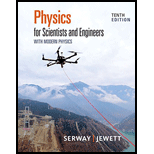
(a)
The total torques due to the weight of the hand about the axis of rotation when the time reads
(a)
Answer to Problem 40AP
The total torques due to the weight of the hand about the axis of rotation when the time reads
Explanation of Solution
Given information: The mass of hour hand is
Formula to calculate the net torque produced by the clock’s hand is,
Here,
Formula to calculate the angular speed of the hour hands is,
Substitute
Thus, the angular speed of the hour hand is
Formula to calculate the angular speed of the minute hands is,
Substitute
Thus, the angular speed of the hour hand is
Let take
Write the expression for the angular position of the hour hands at time
Here,
Substitute
Write the expression for the angular position of the minute hands at time
Here,
Substitute
Substitute
Substitute
When clock shows time
Substitute
Thus, the net torque is
When clock shows time
Substitute
Thus, the net torque is
When clock shows time
Substitute
Thus, the net torque is
When clock shows time
Substitute
Thus, the net torque is
When clock shows time
Substitute
Thus, the net torque is
Conclusion:
Therefore, the total torques due to the weight of the hand about the axis of rotation when the time reads
(b)
The all the time nearest to second when total torque about the axis of rotation is zero by solving the transcendental equation.
(b)
Answer to Problem 40AP
The time corresponding to the zero torque is given as:
| Time(hr) | Clock time |
| 0 | 12:00:00 |
| 0.515 | 12:30:55 |
| 0.971 | 12:58:19 |
| 1.54 | 1:32:31 |
| 1.95 | 1:57:01 |
| 2.56 | 2:33:25 |
| 2.94 | 2:56:29 |
Explanation of Solution
Given information: The mass of hour hand is
From equation (2), the expression for the total torque is given by,
Substitute
Since it is a transcendental equation, solving the equation numerically the values of time comes out to be 0, 0.515, 0.971, 1.54, 1.95……so on.
The time corresponding to the time is given as:
| Time(hr) | Clock time |
| 0 | 12:00:00 |
| 0.515 | 12:30:55 |
| 0.971 | 12:58:19 |
| 1.54 | 1:32:31 |
| 1.95 | 1:57:01 |
| 2.56 | 2:33:25 |
| 2.94 | 2:56:29 |
Conclusion:
Therefore, time corresponding to the zero torque is given as:
| Time(hr) | Clock time |
| 0 | 12:00:00 |
| 0.515 | 12:30:55 |
| 0.971 | 12:58:19 |
| 1.54 | 1:32:31 |
| 1.95 | 1:57:01 |
| 2.56 | 2:33:25 |
| 2.94 | 2:56:29 |
Want to see more full solutions like this?
Chapter 10 Solutions
Physics for Scientists and Engineers with Modern Physics
- 20. Two small conducting spheres are placed on top of insulating pads. The 3.7 × 10-10 C sphere is fixed whie the 3.0 × 107 C sphere, initially at rest, is free to move. The mass of each sphere is 0.09 kg. If the spheres are initially 0.10 m apart, how fast will the sphere be moving when they are 1.5 m apart?arrow_forwardpls help on allarrow_forwardpls help on thesearrow_forward
- pls help on all asked questions kindlyarrow_forwardpls help on all asked questions kindlyarrow_forward19. Mount Everest, Earth's highest mountain above sea level, has a peak of 8849 m above sea level. Assume that sea level defines the height of Earth's surface. (re = 6.38 × 106 m, ME = 5.98 × 1024 kg, G = 6.67 × 10 -11 Nm²/kg²) a. Calculate the strength of Earth's gravitational field at a point at the peak of Mount Everest. b. What is the ratio of the strength of Earth's gravitational field at a point 644416m below the surface of the Earth to a point at the top of Mount Everest? C. A tourist watching the sunrise on top of Mount Everest observes a satellite orbiting Earth at an altitude 3580 km above his position. Determine the speed of the satellite.arrow_forward
- pls help on allarrow_forwardpls help on allarrow_forward6. As the distance between two charges decreases, the magnitude of the electric potential energy of the two-charge system: a) Always increases b) Always decreases c) Increases if the charges have the same sign, decreases if they have the opposite signs d) Increases if the charges have the opposite sign, decreases if they have the same sign 7. To analyze the motion of an elastic collision between two charged particles we use conservation of & a) Energy, Velocity b) Momentum, Force c) Mass, Momentum d) Energy, Momentum e) Kinetic Energy, Potential Energyarrow_forward
- pls help on all asked questions kindlyarrow_forwardpls help on all asked questions kindlyarrow_forward17. Two charges, one of charge +2.5 × 10-5 C and the other of charge +3.7 × 10-6 C, are 25.0 cm apart. The +2.5 × 10−5 C charge is to the left of the +3.7 × 10−6 C charge. a. Draw a diagram showing the point charges and label a point Y that is 20.0 cm to the left of the +3.7 × 10-6 C charge, on the line connecting the charges. (Field lines do not need to be drawn.) b. Calculate the net electric field at point Y.arrow_forward
 Principles of Physics: A Calculus-Based TextPhysicsISBN:9781133104261Author:Raymond A. Serway, John W. JewettPublisher:Cengage Learning
Principles of Physics: A Calculus-Based TextPhysicsISBN:9781133104261Author:Raymond A. Serway, John W. JewettPublisher:Cengage Learning Physics for Scientists and Engineers with Modern ...PhysicsISBN:9781337553292Author:Raymond A. Serway, John W. JewettPublisher:Cengage Learning
Physics for Scientists and Engineers with Modern ...PhysicsISBN:9781337553292Author:Raymond A. Serway, John W. JewettPublisher:Cengage Learning Glencoe Physics: Principles and Problems, Student...PhysicsISBN:9780078807213Author:Paul W. ZitzewitzPublisher:Glencoe/McGraw-Hill
Glencoe Physics: Principles and Problems, Student...PhysicsISBN:9780078807213Author:Paul W. ZitzewitzPublisher:Glencoe/McGraw-Hill Physics for Scientists and Engineers: Foundations...PhysicsISBN:9781133939146Author:Katz, Debora M.Publisher:Cengage Learning
Physics for Scientists and Engineers: Foundations...PhysicsISBN:9781133939146Author:Katz, Debora M.Publisher:Cengage Learning College PhysicsPhysicsISBN:9781305952300Author:Raymond A. Serway, Chris VuillePublisher:Cengage Learning
College PhysicsPhysicsISBN:9781305952300Author:Raymond A. Serway, Chris VuillePublisher:Cengage Learning College PhysicsPhysicsISBN:9781285737027Author:Raymond A. Serway, Chris VuillePublisher:Cengage Learning
College PhysicsPhysicsISBN:9781285737027Author:Raymond A. Serway, Chris VuillePublisher:Cengage Learning





